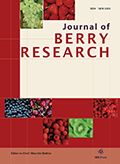Authors: Bhutia, Pema O. | Kewlani, Pushpa | Pandey, Aseesh | Rawat, Sandeep | Bhatt, Indra D.
Article Type:
Research Article
Abstract:
BACKGROUND: Genus Fragaria (family - Rosaceae), popular edible berry fruits with delicious flavor and considerable health benefits has many wild relatives in the Himalayan region. OBJECTIVES: The objective of the study was to characterize variability in morphology, physicochemical properties, phytochemicals, and antioxidant activity in wild Himalayan Strawberry, Fragaria nubicola along the ripening stages and among the genotypes. METHOD: Morphological and physicochemical properties, thiamine, carotenes, total phenolic content, phenolic compounds, total flavonoids, flavonols, tannins, anthocyanins, and antioxidant activity (ABTS, DPPH, and FRAP assays) were determined in four ripening stages of berry fruits. RESULTS:
…Morphological attributes (diameter, length, volume, and fresh weight of berries) have shown considerable variations among the genotypes and increased significantly (p < 0.05) with the ripening stages. The physicochemical properties such as juice content, pH and moisture content also increased with the ripening, however, the pomace content decreased with the ripening. Anthocyanin content increased significantly (p < 0.05) with ripening and reached at maximum level after full ripening. A successive decrease in free and bounded total phenolic, flavonoid, and flavonol contents was observed with the ripening except in total tannin content. However, a reverse trend of these phenolics was observed in juice along with the ripening. The antioxidant activity measured by three in vitro assays increased with the ripening. Phenolics were extracted higher in the acidified methanolic solvent (extracted free and bounded phenolics) as compared to methanolic solvent (extracted free phenolics). Phenolic compounds quantified by RP-HPLC analysis were extracted higher in acidified methanol as compared to methanol, except chlorogenic acid content. CONCLUSION: The results showed quantitative changes in free and bounded phenolics and morphological and functional traits along with the ripening. Also, this important genetic resource exhibited potential utility in the breeding of strawberry improvement programs and as an alternative resource of rich phytonutrients and antioxidants as a functional food.
Show more
Keywords: Antioxidant, berry fruits, genetic resource, himalayan berries, phenolics, wild strawberry
DOI: 10.3233/JBR-210742
Citation: Journal of Berry Research,
vol. 11, no. 3, pp. 481-496, 2021
Price: EUR 27.50





